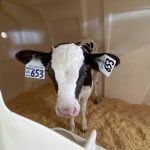Shutting down a hog barn is not as simple as turning off the lights, closing the door and walking away. They require special care if you want to use them again, says engineer Robert Chambers of the Ontario Ministry of Agriculture, Food and Rural Affairs.
Start with any manure still in storage under the pens. “Even in cold temperatures this manure continues to produce manure gases and humidity,” says Chambers.
It can be generating methane, hydrogen sulphide, carbon dioxide and ammonia. When the power is turned off and the ventilation system is shut down, that manure can generate enough methane to cause an explosion that could level the barn.
Read Also

Hands-on with agriculture draws students to AG EX
Urban students flock to MooMania and EweMania at Manitoba AG EX 2025 to get a taste of cattle and sheep production and where their food comes from
“Explosions can be triggered by a pilot light on a heater or a light switch being turned on by someone entering the barn,” Chambers warns.
So rule No. 1: do not turn off the ventilation system until all the manure has been removed from the pits and the pits have been washed out to remove any accumulated solids, Chambers says. “Always leave minimum ventilation fans running to discharge accumulating gas.”
All feed lines should be cleaned out and the feeders emptied. “It would also be a good idea to run some whole grain such as corn or barley to flush the lines of the prepared feed particles as much as possible. “These particles contain salts and other products which when combined with condensation can cause corrosion of the feed system,” Chambers writes on a website for hog producers. Removing all feed will also reduce the attraction of the barn to rodents.
Water lines should be flushed, drained and blown out with air to remove all the water. The main water line coming into the barn should be shut off. Motors and drive chains should be greased to prevent rusting and seizure. The barn, penning and equipment should be washed down and dried out to remove as much of the moisture as possible. Dust on the surfaces is a combination of animal dander feces and feed dust which contains salt.
Manure gases and dust often dissolve in the condensation that forms on colder exterior surfaces and electrical fixtures located on exterior surfaces. Any unprotected metallic surfaces with the exception of stainless steel will degrade rapidly. Minimum heat should be maintained to keep the barn floor and foundation from freezing.
“Of particular concern is empty manure pits,” says Chambers. “Given the right soil type and conditions, frost may crack the exterior walls and then they’ll leak if and when the barn is reopened and manure gathers in the pit.
“In a worst-case situation cracked foundation walls could cause a major structural failure,” he warns. If unvented heaters are used, they must be supplied with fresh air and also have the minimum ventilation functioning to remove the moisture and gasses produced by combustion. “Failure to do this will result in heater failure or severe injury or death by carbon monoxide poisoning to anyone entering the airspace,” he warns.
The barn should be inspected weekly, especially during the heating season, to ensure that both the heaters and the ventilation are running properly. Bait stations should be maintained to eliminate rodents. Electrical and heating systems need to be checked by a qualified professional on an annual basis. Chambers says that if his advice is applied, a hog barn can quickly and easily be brought back into production.














